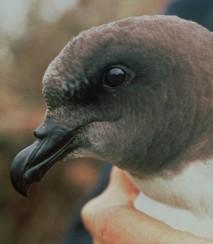
Species and environment
Seabirds
Aotearoa is home to 99 seabird species and subspecies - more than all other countries in the world combined. A total of 55 of these are only found in Aotearoa, and 17 of these species breed in the Chathams. This is more endemic seabirds than any other country. An impressive 28% of Aotearoa's threatened or at-risk seabirds are found here.
The Chathams also has more than 99% of the world's population of northern Buller’s albatrosses and northern royal albatrosses, the largest colony of white-faced storm petrels, and a quarter of the world’s northern giant petrels.
Seabirds play a crucial ecological role in the Chatham Islands. They create a link between the land and ocean central to the health of remote islands like these.
With a diet of fish, seabird guano is rich in nutrients. When they come in to nest or sleep at night, their guano acts as a fertiliser that allows plants to grow. These plants in turn create habitat for other species, and also stabilise the soil and prevent erosion. This is an essential part of the nutrient cycle between ocean and land.
Learn more about the Chatham Islands' seabird-driven ecosystem
Seabirds are part of the ocean food chain and play a part in keeping marine ecosystems in balance. This also contributes to a healthy fishery for humans - but is also one reason why seabirds are a good indicator of the health of ecosystems. When seabirds are no longer abundant, it can be an indicator that something is wrong within the ecosystem.
Here are two of the Chatham Island seabirds we wanted to draw special attention to.
Tāiko

Taiko close up
The tāiko, or magenta petrel, is believed to be the world's rarest seabird, with a population of less than 200. It is another of the Chathams' iconic conservation species, thought to be extinct for over a century until it was rediscovered in 1978.
This seabird is a medium-sized petrel, grey and white with a dark hooded head. It nests in burrows scattered through dense forest, feeding at sea during the day and coming in at night.
Taiko are currently found in the southern part of Rēkohu/Wharekauri/main Chatham, most famously in the Tuku. The Chatham Taiko Trust is instrumental in the conservation work taking place to protect these birds - and hopefully see them start to expand. The predator fence at Sweetwater was set up to try to establish a new colony.
A loss of habitat and introduced mammalian predators are probably the biggest contributing factors to their decline. They’re vulnerable when leaving their burrows and rats can easily get into their burrows and kill chicks while parents are foraging during the day.
Albatrosses

Chatham Island albatross and chick
A number of albatross species call the Chatham archipelago home. The rich oceans provide excellent foraging ground for these birds. Some of the remote islets, particularly the Pyramid, provide excellent nesting habitat. However, they do also show up on the main islands - most notably an Antipodean albatross nest on Pitt Island.
Species here include the Antipodean, northern royal, Bullers or Pacific, and Chatham Island mollymawk. Most of the world's population of northern Bullers and northern royal albatross breed in the Chathams.
The Chatham Island mollymawk (or Chatham albatross, or toroa) is endemic to the Chathams. They have a distinctive look, with dark grey heads and necks, white behind their eyes, and a thick black line in front of the eye that extends out towards the bill. Their upper wings and back are black-brown.
How to help
Seabirds are often directly impacted by our actions. Do what you can to avoid disturbing them - like keeping clear of nesting spots during breeding season, keeping dogs under control and cats inside at night, and steering your boat around a feeding flock if you're out at sea.
You can dispose of your rubbish responsibly so it doesn't end up in the ocean. Plastics can cause a particular problem for seabirds and other sealife, who will sometimes mistake floating rubbish for food and eat it. This can lead to suffocation or, if the undigestable plastic is sitting in their stomach, starvation.
Seabirds can accidentally get caught in fishing gear. Using weighted lines, barbless hooks, and artificial lures reduces the chance of accidentally hooking a seabird. And don't feed them - firstly, it's better not to train wild animals to see humans as providers of food, and secondly, a lot of human food is not good bird food!
You could also get involved in shoreline restoration work to improve and protect seabird habitats, or predator control programmes.







